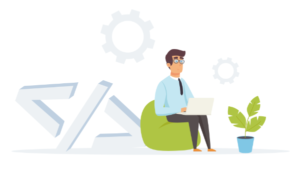This article was sponsored by LinkAssistant. Thank you for supporting the sponsors who make SitePoint possible.
Your website is often the face of your company, and there are oh so many reasons to give your website a facelift. Maybe it’s time to ramp up the functionality and enhance usability. Maybe the purpose of your site has changed, or its social media integration isn’t up to snuff. Maybe it still looks like this.
Whatever the reason, retaining – and even improving – your site’s SEO should be high up on your checklist.
Otherwise, your site will face heavy traffic loss, and all that work will be for naught. Sure, you may have poured significant time and money into your site’s overhaul, but if users can’t find the site, you’ve just remodeled a house with no address, on an island, an invisible island, in outer space.
To avoid traffic loss and conquer the search engines, here are five important considerations for an SEO-friendly redesign.
1. Ensure All Content is Indexable
In order for a web page to be ranked in a search engine, it must be indexed by web crawlers. Think of these crawlers as an army of Pac-Men who scour webpages for little yellow dots of data. The crawlers then deliver that data to the search engine servers, where it’s catalogued and stored, much like a library.
But crawlers are picky eaters, and can only index certain types of data. In order for your content to be indexable, it must be formatted in a way that’s compatible with the crawlers’ particular dietary needs. Here are some guidelines:
- Any content you want indexed should be written in HTML.
- Any images you want indexed should contain alt tags.
- If your website has video or audio content, and you’d like that content to be indexed, include a written transcript on the website.
- Restricted pages, such as pages only accessible via a form or password, are not indexable, so avoid them when possible.
- Unless you’re dealing with sensitive information, avoid any instances of robots.txt. A robots.txt tells crawlers _not _to scan or process certain areas of a website.
If you’re having trouble deciding on what is and what is not indexable, or you want to verify your site’s indexability after redesign, use the following tools:
- Run Link Assistant’s Website Auditor to check for indexing and crawlability errors.
- Use Cached View to see a visual representation of a webpage’s indexable content.
- Take a mental break and play Pac-Man.
2. Optimize On-Page Content
On-page content refers to everything that is visible to a user, and during a website redesign, that content is often the first on the firing lines.
Redesigns often involve reorganizing how the on-page content is presented and structured. Content may also be moved, reworked, or outright deleted. Furthermore, the SEO landscape is always evolving, and on-page ranking factors have changed over time. If it’s been a few years since you last updated your site, use the redesign as an opportunity to update your on-page SEO so it conforms with the current best practices.
To optimize on-page content, start by optimizing keyword density. In 2012, Google introduced a new algorithm called Penguin which cracked down on certain black hat SEO tactics. One of the first on the chopping block was keyword stuffing: the practice of overloading content with as many keywords as possible. Now, to achieve optimal keyword density, each piece of content should focus only on one or two highly relevant keywords, and these keywords should appear only when it makes contextual sense.
It’s also important to reevaluate the keywords themselves. Let’s say you run a company that sells high-end coffee appliances. At the time of the site’s conception, a popular keyword may have been “coffee maker ratings” But search trends change, and today, the keyword “best coffee maker” actually sees more traffic.
To find the best keywords for your content, use Link Assistant’s Rank Tracker.
The new SEO rules are also much harder on issues like thin-content pages and empty, duplicate, or overly-long titles. Go back over your website’s content and correct these mistakes. If you’d rather not rely on your naked eye to catch every error, Link Assistant’s Website Auditor can check these issues for you.
3. Reformat URL Structures
Not even URL structures were immune to Google Penguin. Crawlers used to happily chow down on URLs that looked like this:
http://www.example.com/452352342352heufnrne37geb.
But nowadays they strongly prefer URLs that look like this:.
The anatomy of an SEO-friendly URL follows this hierarchy:
- Protocol
- Subdomain
- Domain
4.Top-Level Domain
- Folders/Paths
- Page
- Named Anchor
When redesigning your site, use Link Assistant’s Website Auditor to detect poorly formatted URLs.
4. Fix Broken Links
The fallout of a site redesign will inevitably include broken links. These are hyperlinks that point to an unavailable web page, and boy are they bad for SEO. Links get broken in a few ways:
- If you reformat your URLs, any backlink pointing to your old URL will be broken.
- A website on the other end of one of your outbound links may have shutdown, the web page may have been deleted, or the web page’s URL may have changed.
- During your redesign, a web page on the other end of one of your inbound links may have been deleted, or you may have reformatted its URL.
Use Link Assistant’s Website Auditor to identify all of your site’s broken links, then fix backlinks and inbound links with 301 redirects. A 301 redirect permanently redirects a broken link to its new, fully operational counterpart. A 301 redirect also transfers most of the original link’s ranking power.
5. Customize 404s
Flat out deleting a page is never ideal, but part of redesigning a site requires taking out the trash. A deleted page results in a 404 error, and although 404 errors don’t directly affect SEO, they do affect user experience.
Unless you get a little creative…
404 pages don’t have to be an eyesore, nor do they have to be a user deterrent. As they say, one man’s trash is another man’s treasure, and one website’s 404 page is another website’s marketing tool.
In the rare occasion you end up with a 404 page, use the opportunity to customize it. When done properly, the page can be informative and entertaining, and actually de_crease _bounce rates. Here are some great resources which will help you customize your 404 page:
Create Useful 404 Pages
How To Design a 404 Page That Keeps Visitors On Your Site
50 Funny & Creative Error 404 Pages
Conclusion
A website redesign can cause SEO trauma, which will end up costing you in the traffic and rankings department. To head off any potential damage, integrate SEO into the redesign process by ensuring all content is indexable and optimized for today’s SEO best practices. Review content for issues such as keyword stuffing and overly-long titles, and if you feel like going above and beyond, update your keywords to be more timely. Don’t forget to fix broken links, especially if you’ve reformatted your URLs, and have some fun with your 404s.
Link-Assistant.Com have recently published their own guide to SEO friendly website redesign, you might want checking it out as well.
 Joshua Kraus
Joshua KrausJosh Kraus is a Chicago-born, Denver-based writer and mediocre autobiographist with an interest in art, entrepreneurship, and emerging industries. When he's not writing, he attends to his t-shirt business, Bird Fur. Find him at joshkra.us and birdfurtees.com.



